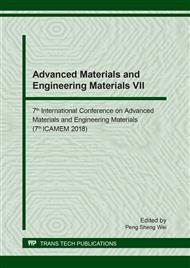p.294
p.300
p.306
p.311
p.316
p.322
p.327
p.333
p.339
Influence of Magnetic Field on Formation of Short Range Order Regions in Liquid Metals: Fluctuation Hypothesis
Abstract:
The aim of this investigation is to provide theoretical justification of the crystallizing nucleus formation in liquid iron. To solve this problem, the authors put forward the fluctuation hypothesis: short range order region formation in liquid metal takes place due to temperature fluctuations, and the temperature of the short range order is the temperature fluctuation around Kelvin scale zero in the course of crystallization time. The investigations were carried out for liquid state of the substance, in particular, for iron in paramagnetic state at the melting temperature. Analytical derivation of the temperature fluctuation value was given. Analytical expressions were obtained to define the average number of atoms in the short range order region for crystallizing iron. The investigation results show that short range order contains enough atoms to provide interaction with pulsed magnetic field resulting in the increase in the number of crystallization nuclei and in the decrease of their size. The obtained results can be used in the decision-making process concerning some manufacturing operations aimed at providing homogeneous structure of metals, particularly, in ferrous and non-ferrous metallurgy.
Info:
Periodical:
Pages:
316-321
Citation:
Online since:
August 2018
Authors:
Price:
Сopyright:
© 2018 Trans Tech Publications Ltd. All Rights Reserved
Share:
Citation:


